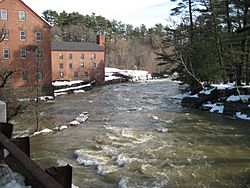Royal River facts for kids
Quick facts for kids Royal River |
|
|---|---|

The Royal River in Yarmouth, Maine, a few hundred yards northwest of its mouth at Casco Bay
|
|
| Other name(s) | Yarmouth River (old) |
| Country | United States |
| Physical characteristics | |
| Main source | Sabbathday Lake New Gloucester, Maine 43°59′18″N 70°20′58″W / 43.98833°N 70.34944°W |
| River mouth | Casco Bay Yarmouth, Maine 43°47′51.4″N 70°10′37.9″W / 43.797611°N 70.177194°W |
| Length | 39 mi (63 km) |
The Royal River is a small river in southern Maine. It is about 39 miles (63 km) long. The river starts at Sabbathday Lake in New Gloucester. It then flows through towns like Auburn, Gray, and North Yarmouth. Finally, it empties into Casco Bay at Yarmouth.
The river was once called the Yarmouth River. In the 1700s and 1800s, it was very important for the economy of Yarmouth. Its strong flow powered many mills. For example, the Forest Paper Company built a mill in 1872. This mill was on the land where Royal River Park is today.
The Royal River is mentioned in some books by Maine author Stephen King. In his story The Body, the characters cross the river. It also appears in 'Salem's Lot and Rita Hayworth and Shawshank Redemption.
Contents
River's Name and History
The Royal River is named after William Royall (1580–1676). He was one of the first European settlers in the area. His name was spelled with two "L"s, but the river's official name has only one.
Why the Name is Discussed
Some people are talking about changing the river's name back to its original Native American name. This discussion comes from an article called "Muddy Waters." It brings up the Royall family's past connections to the slave trade in Antigua.
- Sir Ronald Sanders, an ambassador, believes the name should be changed. He feels that the name celebrates a painful history.
- Dr. Natasha Lightfoot, a history professor, also supports changing the name. She says keeping the name makes the river a reminder of the difficult history of slavery. She suggests finding out what First Nations or Native American groups lived near the river. Then, the river could be named after them to honor their history.
Early European Settlement
William Royall came to America from England in 1629. He worked for the Massachusetts Bay Company. As a reward, he received land near the Westcustogo River. This river was later renamed the "Royal River."
William Royall first lived at Fogg's Point in Freeport, Maine. Later, he moved to Royall's Farm. This farm was located between the Royal River and the Cousins River. Because of conflicts between settlers and Native Americans, William and his family moved to Dorchester, Massachusetts, in 1675. He passed away a year later.
The Royall Family's Later History
William's grandson, Isaac Royall Sr. (1672–1739), became a merchant. He traded rum and sugar. He also sought to make money from the slave trade. By 1700, he was in Antigua. He partly owned a ship called the Mayflower, which was used in the slave trade. His son, Isaac Royall Jr, was born in Antigua in 1719. Isaac Royall Jr. later played a part in starting Harvard Law School.
Images for kids
-
The source of the Royal River at Sabbathday Lake in New Gloucester, Maine, looking south towards the lake



